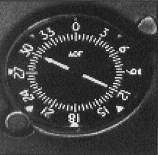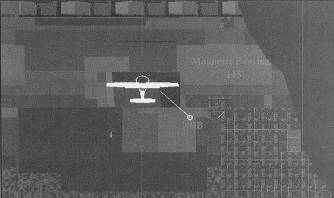Microsoft Flight Simulator Handbook
by Jonathan M. Stern
NDB Basics
An automatic direction finder (ADF) is a relatively simple radio receiver with a display needle that points directly at the transmitter to which it is tuned. In this respect, it is far simpler than a VOR receiver. Nonetheless, many pilots are confused by the use of an ADF.
The ADF display consists of a single needle mounted over a compass rose. Figure 18.23 shows the ADF display.

In some aircraft, the compass card can be manually rotated so that the needle overlays a compass card manually aligned with the aircraft's heading. A more sophisticated variation of this instrument is the radio magnetic indicator, or RMI, which places the ADF needle over the face of a gyroscopic heading indicator. Flight Simulator uses an ADF display with a fixed compass card.
Unlike a VOR, ADF guidance is relative to the heading of the aircraft. The 0 on the compass rose represents the nose of the airplane and the 18 represents the tail. If the needle points to the 6, the NDB to which the ADF is tuned is 60° to the right of the airplane's nose (see Figure 18.24).

This 60° is referred to as the relative bearing of the NDB. The heading that points the airplane right at the NDB is called the magnetic bearing. The magnetic bearing is determined by adding the relative bearing to the airplane's current heading. For example, if the airplane's current heading is 085° and the relative bearing is 60°, the magnetic bearing is 145°.
If the relative bearing is 300° and the magnetic heading is 205°, an additional step is necessary to compute the magnetic bearing. Because headings, bearings, and courses range from 1° to 360°, the magnetic bearing cannot be 505 degrees. If the sum of the magnetic heading and the relative bearing exceeds 360°, 360° must be subtracted from the sum to find the magnetic bearing. Therefore, the magnetic bearing is 505° – 360°, or 145 degrees (see Figure 18.25).

You should not be surprised that the result was the same in both examples. The airplane used in this example stayed in the same position when it turned from a heading of 85° to 205°. As the airplane turned, the ADF needle turned at the same rate. Because the airplane was in the same position both times, it only makes sense that the same heading now points the airplane at the NDB (see Figure 18.26).

Table of Contents
Previous Section: NDB Approaches
Next Section: NDB Tracking Procedures
